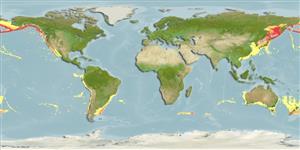Classification / Names
Common names from other countries
Main reference
Size / Weight / Age
Max length : 440 cm TL male/unsexed; (Ref. 247); 430.0 cm TL (female)
Environment
Marine; benthopelagic; depth range 0 - 2000 m (Ref. 26346)
Climate / Range
Temperate, preferred 18°C (Ref. 107945); 70°N - 47°S
Distribution
Short description
Dorsal
spines
(total): 0;
Anal
spines: 0;
Anal
soft rays: 0. Diagnosis: Somniosus pacificus differs from S. antarcticus by the following characters: interdorsal space about 70% of prebranchial length (vs. 80%); height of first dorsal fin about 3.7% of precaudal length (PCL) (vs. 3.0%); height of second dorsal fin about 3.4% of PCL (vs. 2.9%); number of turns in spiral valve 32-37 (mode 33) (vs. 36-41, mode 39); precaudal vertebrae 28-30 (mode 29) (vs. 30-31, mode 30) (Ref. 50224).
IUCN Red List Status (Ref. 115185)
Human uses
Fisheries: of no interest
More information
ReferencesAquacultureAquaculture profileStrainsGeneticsAllele frequenciesHeritabilityDiseasesProcessingMass conversion
Tools
Special reports
Download XML
Internet sources
Estimates of some properties based on models
Phylogenetic diversity index
PD50 = 0.5313 many relatives (e.g. carps) 0.5 - 2.0 few relatives (e.g. lungfishes)
Trophic Level
4.4 ±0.4 se; Based on diet studies.
Resilience
Low, minimum population doubling time 4.5 - 14 years (Fec=300; assuming tm<=10)
Vulnerability
Very high vulnerability (87 of 100)
Price category
